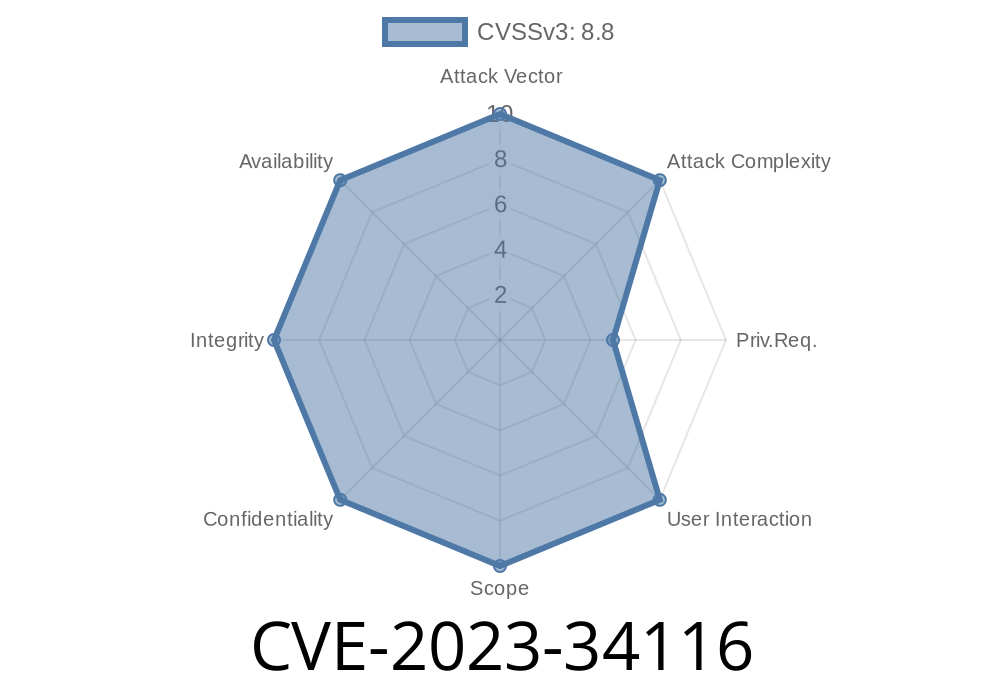---
CVE-2023-34116 is a security vulnerability in the Zoom Desktop Client for Windows that could allow attackers to escalate their privileges on a target system. Let’s break down what this means, how it works, and what you should do about it. We'll look at some simple code examples based on public information and discuss the impact in plain English.
What is CVE-2023-34116?
CVE-2023-34116 refers to an "improper input validation" bug found in Zoom's Desktop Client for Windows. Specifically, this means Zoom was not checking some inputs from the network as strictly as it should have. As a result, it was possible for attackers to send specially crafted packets and trick Zoom into performing operations they shouldn't be able to—including escalating their privileges.
The bug affected versions before 5.15., which was released in June 2023.
- CVE Entry: https://nvd.nist.gov/vuln/detail/CVE-2023-34116
- Zoom Security Bulletin: https://explore.zoom.us/en/trust/security/security-bulletin/
Improper Input Validation Explained
Input validation is a basic security practice where programs check if incoming data (from users or the network) is safe before processing it. If input is not checked properly, attackers can trick the program into doing things it shouldn’t.
In the case of Zoom, this bug let an unauthorized user (meaning NOT logged in or authenticated) leverage network access to pass unexpected data, ultimately exploiting Zoom’s system-level processes.
How Exploitation Works
1. Client Running: Victim is running an old version of Zoom Desktop Client (before 5.15.) on Windows.
2. Attacker on Network: Attacker is on the same network (could be Wi-Fi, LAN, or even over the internet under certain conditions).
3. Sending Bad Packets: Attacker sends packets crafted in a way that abuses the faulty input checks.
4. Privilege Escalation: Zoom processes the data without proper filtering, allowing the attacker to run commands or operations as a more privileged user.
Sample Exploit Code (Simplified)
While the exact exploit code isn't public for safety reasons, here's what a theoretical attack might look like, based on common patterns in similar input validation flaws.
Suppose Zoom is running a local HTTP or IPC service for internal communications
import socket
# Set the target to the victim's local IP and service port
target_ip = 'victim_ip_here'
target_port = 880 # Example; real port may differ
# Craft a malicious packet
malicious_payload = b"POST /api/upgrade HTTP/1.1\r\nHost: localhost\r\nContent-Length: 100\r\n\r\n{\"cmd\":\"run_as_admin\",\"data\":{\"command\":\"cmd.exe /c whoami > C:\\temp\\pwned.txt\"}}"
# Open a socket and send the payload
with socket.socket(socket.AF_INET, socket.SOCK_STREAM) as s:
s.connect((target_ip, target_port))
s.sendall(malicious_payload)
response = s.recv(4096)
print(response.decode())
Note: The above is a simplified illustration. Actual details about Zoom's IPC mechanisms are not public, but the general concept is - attackers send unexpected commands or data, and due to missing checks, the system executes them with higher privileges.
Any Windows user running Zoom Desktop Client before version 5.15..
- Especially risky if the computer is on public/shared networks (e.g., university Wi-Fi, public hotspots, company LANs).
Make sure you’re running Zoom Desktop Client version 5.15. or later.
Use Endpoint Security
A good antivirus/firewall can block suspicious local network traffic.
References
- NIST CVE-2023-34116
- Zoom Security Bulletin (June 2023)
- Zoom Download Center (Get Latest Version)
Conclusion
CVE-2023-34116 highlights how even trusted, widely used apps like Zoom can have dangerous bugs that attackers can exploit—sometimes without much effort. While Zoom has released a fix, it’s crucial to keep software up to date and pay attention to network security.
If you’re an IT admin, roll out the latest Zoom client across your organization. If you’re a regular user, don’t ignore those update prompts!
Stay safe, patch your software, and stay aware.
*Exclusive research and plain-English breakdown by ChatGPT*
Timeline
Published on: 07/11/2023 17:15:00 UTC
Last modified on: 07/18/2023 21:08:00 UTC
